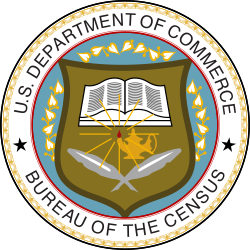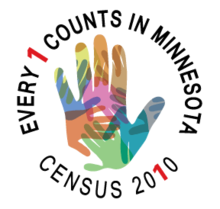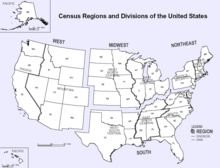| Year
|
Total population
|
Change in population
|
Most populated state
|
Most populated city
|
Ethnic demographics counted[29]
|
Slaves
|
Notes
|
| 1790[b]
|
3,929,326[c]
|
—
|
 Virginia Virginia
(747,610)
|
 New York, NY New York, NY
(33,131)
|
Free white females and males, other free persons, slaves
|
694,280
|
Original numbers were corrected later.
|
| 1800[d]
|
5,308,483[e]
|
 35% 35%
|
 Virginia[f] Virginia[f]
(676,682)
|
 New York, NY New York, NY
(60,515)
|
Free white females and males, other free persons, slaves
|
893,605[g]
|
Original numbers were corrected later.
|
| 1810[h]
|
7,239,881
|
 36% 36%
|
 New York New York
(959,049)
|
 New York, NY New York, NY
(96,373)
|
Free white females and males, other free persons, slaves
|
1,191,362
|
The authorizing act of the third census stipulated that each marshal (enumerator) must personally visit each household, rather than rely on hearsay.
|
| 1820[i]
|
9,638,453
|
 33% 33%
|
 New York New York
(1,372,812)
|
 New York, NY New York, NY
(123,706)
|
Free white females and males, other free persons, free people of color, slaves
|
1,538,022
|
—
|
| 1830[j]
|
12,866,020
|
 33% 33%
|
 New York New York
(1,918,608)
|
 New York, NY New York, NY
(202,589)
|
Free white females and males, other free persons, free people of color, slaves
|
2,009,043
|
—
|
| 1840[k]
|
17,069,453
|
 33% 33%
|
 New York New York
(2,428,921)
|
 New York, NY New York, NY
(312,710)
|
Free white females and males, other free persons, free people of color, slaves
|
2,487,355
|
The census estimated the population of the United States at 17,100,000. The results were tabulated by 28 clerks in the Bureau of the Census.
|
| 1850[l]
|
23,191,876
|
 36% 36%
|
 New York New York
(3,097,394)
|
 New York, NY New York, NY
(515,547)
|
Black, Mulatto, White
|
3,204,313
|
The 1850 census was a landmark year in American census-taking. It was the first year in which the census bureau attempted to record every member of every household, including women, children and slaves. Accordingly, the first slave schedules were produced in 1850. Prior to 1850, census records had only recorded the name of the head of the household and tabulated the other household members within given age groups.
|
| 1860[m]
|
31,443,321
|
 35% 35%
|
 New York New York
(3,880,735)
|
 New York, NY New York, NY
(813,669)
|
Indian, Chinese, Black, Mulatto, White
|
3,953,761
|
The results were tabulated by 184 clerks in the Bureau of the Census. This was the first census where American indigenous people officially were counted, but only those who had 'renounced tribal rules'. The figure for the nation was 40,000.
|
| 1870[n]
|
39,818,449[o]
|
 23% 23%
|
 New York New York
(4,382,759)
|
 New York, NY New York, NY
(942,292)
|
Indian, Chinese, Black, Mulatto, White
|
—
|
The first census to provide detailed information on the black population, only years after the culmination of the Civil War when slaves were granted freedom. The results are controversial, as many believed it underestimated the true population numbers, especially in New York and Pennsylvania.
|
| 1880[p]
|
50,189,209
|
 30% 30%
|
 New York New York
(5,082,871)
|
 New York, NY New York, NY
(1,206,299)
|
Indian, Chinese, Black, Mulatto, White
|
The first census that permitted women to be enumerators. Also led to the discovery of Alabama paradox.
|
| 1890[q][n 1]
|
62,947,714
|
 25% 25%
|
 New York New York
(6,003,174)
|
 New York, NY New York, NY
(1,515,301)
|
Indian, Chinese, Japanese, Black, Mulatto, Quadroon, Octaroon, White
|
Because it was believed that the frontier region of the United States no longer existed, the tracking of westward migration was not tabulated in the 1890 census.[30] This trend prompted Frederick Jackson Turner to develop his milestone Frontier Thesis.
The 1890 census was the first to be compiled using the new tabulating machines invented by Herman Hollerith. The net effect of the many changes from the 1880 census (the larger population, the number of data items to be collected, the Census Bureau headcount, the volume of scheduled publications, and the use of Hollerith's electromechanical tabulators) was to reduce the time required to fully process the census from eight years for the 1880 census to six years for the 1890 census.[31] The total population, of 62,947,714, was announced after only six weeks of processing (punched cards were not used for this family, or rough, count).[32][33] The public reaction to this tabulation was disbelief, as it was widely believed that the "right answer" was at least 75,000,000.[34]
This census is also notable for the fact it is one of only three for which the original data are no longer available. Almost all the population schedules were destroyed following a fire in 1921.
|
| 1900[r]
|
76,212,168
|
 21% 21%
|
 New York New York
(7,268,894)
|
 New York, NY New York, NY
(3,437,202)
|
Indian, Chinese, Japanese, Black (Negro or of Negro descent), White
|
—
|
| 1910[s]
|
92,228,496
|
 21% 21%
|
 New York New York
(9,113,614)
|
 New York, NY New York, NY
(4,766,883)
|
Indian, Chinese, Japanese, Black (Negro), Mulatto, White, other
|
—
|
| 1920[t]
|
106,021,537
|
 15% 15%
|
 New York New York
(10,385,227)
|
 New York, NY New York, NY
(5,620,048)
|
Indian, Chinese, Filipino, Hindu, Japanese, Korean, Black (Negro), Mulatto, White, other
|
This was the first census that recorded a population exceeding 100 million.
|
| 1930[u][n 2]
|
122,775,046
|
 13% 13%
|
 New York New York
(12,588,066)
|
 New York, NY New York, NY
(6,930,446)
|
Indian, Chinese, Filipino, Hindu, Japanese, Korean, Negro, Mexican, White, other
|
—
|
| 1940[v]
|
132,164,569
|
 7% 7%
|
 New York New York
(13,479,142)
|
 New York, NY New York, NY
(7,454,995)
|
Indian, Chinese, Filipino, Hindu, Japanese, Korean, Negro, White, other
|
—
|
| 1950[w]
|
150,697,361
|
 14% 14%
|
 New York New York
(14,830,192)
|
 New York, NY New York, NY
(7,891,957)
|
American Indian, Chinese, Filipino, Japanese, Negro, White, other
|
The most recent census where individuals' data have now been released to the public (by the 72-year rule).
|
| 1960[x]
|
179,323,175
|
 19% 19%
|
 New York New York
(16,827,000)
|
 New York, NY New York, NY
(7,781,984)
|
Aleut, American Indian, Eskimo, Chinese, Filipino, Japanese, Negro, Hawaiian, part-Hawaiian, White
|
Will be available for public inspection on April 1, 2032.
|
| 1970[y]
|
203,302,031
|
 13% 13%
|
 California California
(19,953,134)
|
 New York, NY New York, NY
(7,894,862)
|
American Indian, Chinese, Filipino, Japanese, Korean, Negro or Black, Hispanic origin, Mexican, Puerto Rican, Cuban, Central or South American, Hawaiian, White, other
|
The first census that recorded a population exceeding 200 million. Will be available for public inspection on April 1, 2042.
|
| 1980[z]
|
226,545,805
|
 11% 11%
|
 California California
(23,667,902)
|
 New York, NY New York, NY
(7,071,639)
|
Aleut, Eskimo, American Indian, Asian Indian, Chinese, Filipino, Japanese, Korean, Vietnamese, Black or Negro, Hispanic origin, Mexican, Mexican-American, Chicano, Puerto Rican, Cuban, other Hispanic, Hawaiian, Guamanian, Samoan, White, other
|
Will be available for public inspection on April 1, 2052.
|
| 1990[aa]
|
248,709,873
|
 10% 10%
|
 California California
(29,760,021)
|
 New York, NY New York, NY
(7,322,564)
|
Aleut, Eskimo, American Indian, Asian or Pacific Islander, Chinese, Filipino, Korean, Vietnamese, Japanese, Asian Indian, other API, Black or Negro, Hispanic origin, Mexican, Mexican-American, Chicano, Puerto Rican, Cuban, other Hispanic, Hawaiian, Guamanian, Samoan, White, other race
|
Will be available for public inspection on April 1, 2062.
|
| 2000[ab]
|
281,421,906
|
 13% 13%
|
 California California
(33,871,648)
|
 New York, NY New York, NY
(8,008,278)
|
American Indian, Alaska Native, Asian Indian, Chinese, Filipino, Japanese, Korean, Vietnamese, other Asian, Black, African American, or Negro, Hispanic origin, Mexican, Mexican-American, Chicano, Puerto Rican, Cuban, other Hispanic, Hawaiian, Guamanian or Chamorro, Samoan, other Pacific Islander, White, other race
|
Will be available for public inspection on April 1, 2072.
|
| 2010[ac]
|
308,745,538
|
 10% 10%
|
 California California
(37,253,956)
|
 New York, NY New York, NY
(8,175,133)
|
American Indian, Alaska Native, Asian Indian, Chinese, Filipino, Japanese, Korean, Vietnamese, other Asian, Black, African American, or Negro, Hispanic origin, Mexican, Mexican-American, Chicano, Puerto Rican, Cuban, other Hispanic, Hawaiian, Guamanian or Chamorro, Samoan, other Pacific Islander, White, other race
|
The first short-form-only census since 1940, as the decennial long form has been replaced by the American Community Survey. The first census that recorded a population exceeding 300 million. Will be available for public inspection on April 1, 2082.
|
| 2020[ad]
|
331,449,281
|
 7% 7%
|
 California California
(39,538,223)
|
 New York, NY New York, NY
(8,804,190)
|
American Indian, Alaska Native, Asian Indian, Chinese, Filipino, Japanese, Korean, Vietnamese, other Asian, Chamorro, Native Hawaiian, Samoan, other Pacific Islander, Black or African American, Hispanic, Latino or Spanish origin, Chicano, Cuban, Mexican, Mexican American, Puerto Rican, another Hispanic origin, White, some other race
|
The first U.S. census to offer options to respond online or by phone, in addition to the option to respond on a paper form as with previous censuses. Will be available for public inspection on April 1, 2092.
|






